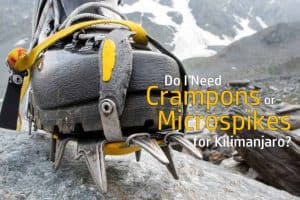We understand you have many choices when it comes to Kilimanjaro guide services. But when selecting an operator, your safety should take precedence over any other consideration. Beware of companies that downplay the potential dangers of high altitude trekking. They are more focused on selling you a trip than helping you make an informed decision.
In this article, we examine what dangers you may face while climbing Kilimanjaro and what we do to minimize the risks.
- Safety Precautions
- Acute Mountain Sickness (AMS)
- Daily Health Checks
- Diamox – Altitude Medication
- Kilimanjaro Rescue
Safety Precautions

High altitude trekking is inherently risky. It’s the nature of being on such a tall, expansive mountain such as Kilimanjaro, situated far away from medical facilities. Total safety can never be guaranteed – by anyone. Deaths can and do occur on the mountain.
When you choose to climb with Ultimate Kilimanjaro®, you are literally entrusting us with your life. That fact is not lost on us. We take your health and safety very seriously.
We have a comprehensive safety system that was co-developed with the knowledge and expertise of professional mountaineers, western doctors and altitude experts. For starters, all of our guides are certified Wilderness First Responders (WFR), meaning they are trained to respond to emergency situations in remote locations. We conduct health checks twice a day to monitor oxygen saturation levels and heart rates. We carry bottled oxygen on every climb. And much, much more.
Many companies that operate on Kilimanjaro are not capable of handling life-threatening emergencies.
Acute Mountain Sickness (AMS) on Kilimanjaro

Anyone who travels to high altitude is subject to altitude related illnesses. The most common illness is Acute Mountain Sickness (AMS), also known as altitude sickness. The leading cause of AMS is ascending to a high elevation too quickly and not allowing the body sufficient time to acclimatize, or adapt to lower oxygen levels.
Most people who climb Kilimanjaro will experience one or more symptoms of altitude sickness at some point in their journey. The symptoms of mild AMS include:
- Headache
- Nausea & Dizziness
- Loss of appetite
- Fatigue
- Shortness of breath
- Disturbed sleep
- General feeling of malaise
As long as symptoms remain mild, it is generally acceptable for that person to continue climbing.
Daily Health Checks

The cornerstone of our health and safety program is the daily health check.
Ultimate Kilimanjaro® guides will measure and record your oxygen saturation and heart rate twice per day. This is done with a device known as a pulse oximeter, which uses a light beam to estimate the oxygen in the blood. The oxygen saturation and pulse readings over a period of time can give an indication of how well a person is acclimatizing.
Our guides will also ask you specific questions in accordance with a questionnaire known as the Lake Louise Scoring System (LLSS). LLSS was created as a tool to evaluate the degree of AMS someone might or might not have.
Diamox – Altitude Medication

Diamox (acetazolamide) is a prescription drug that is used to prevent and treat altitude sickness. It is the standard medical prophylaxis agent for AMS. It works by increasing ventilation (breathing rate) and thus, improving oxygenation.
A misconception often heard about Diamox is that it only masks symptoms of AMS. This is false. Diamox does not mask the symptoms of AMS. It is effective in the prevention and treatment of AMS and has FDA approval for this use.
Kilimanjaro Rescue

In the event of an emergency on the mountain, Ultimate Kilimanjaro® guides are trained to take swift action. Because of our established protocols, there is never any question on how to best resolve an issue. Whether it is a sprained ankle, hypothermia, exhaustion, or altitude sickness, our guides are capable of getting you to safety.
We can coordinate a rescue from anywhere in the park. On the mountain, our teams carry bottled oxygen on every climb. Oxygen can be used to treat AMS in conjunction with a quick descent. Additionally, we can initiate helicopter evacuation through third party service Kili MedAir.
Kilimanjaro Safety Recap

- Climbing Kilimanjaro is inherently dangerous due to its high altitude.
- Acute Mountain Sickness (AMS) or altitude sickness is very common on Kilimanjaro.
- Diamox is a prescription drug effective for preventing and treating AMS.
- Ultimate Kilimanjaro® practices comprehensive, practical and effective safety protocols including conducting twice daily health checks, carrying bottled oxygen, and having established rescue procedures.
- Most Kilimanjaro operators do not have meaningful safety systems in place and aren’t prepared for emergencies.
Recent Safety Blog Posts
- Do I Need Crampons or Microspikes for Kilimanjaro?

- Climbing Kilimanjaro Over 50 (Am I Too Old?)

- What Happens to the Human Body on Mount Kilimanjaro?

- Boost Oxygen Review: Does it Work?

- 7 Hard Truths About Climbing Kilimanjaro (That You Need to Know)

- Mount Everest’s Death Zone: What Happens to the Human Body?

- Why Do Climbers Summit Kilimanjaro at Night?

- Climbing Kilimanjaro During Covid (Updated June 1, 2023


